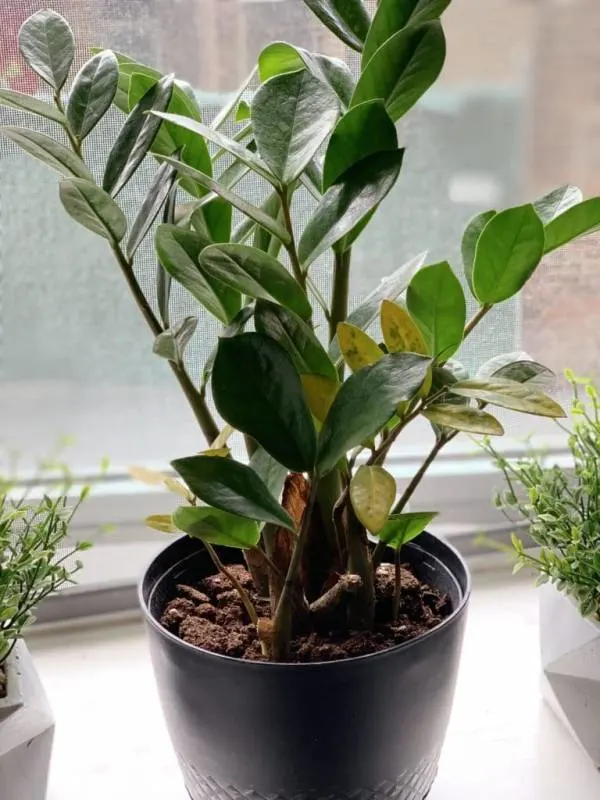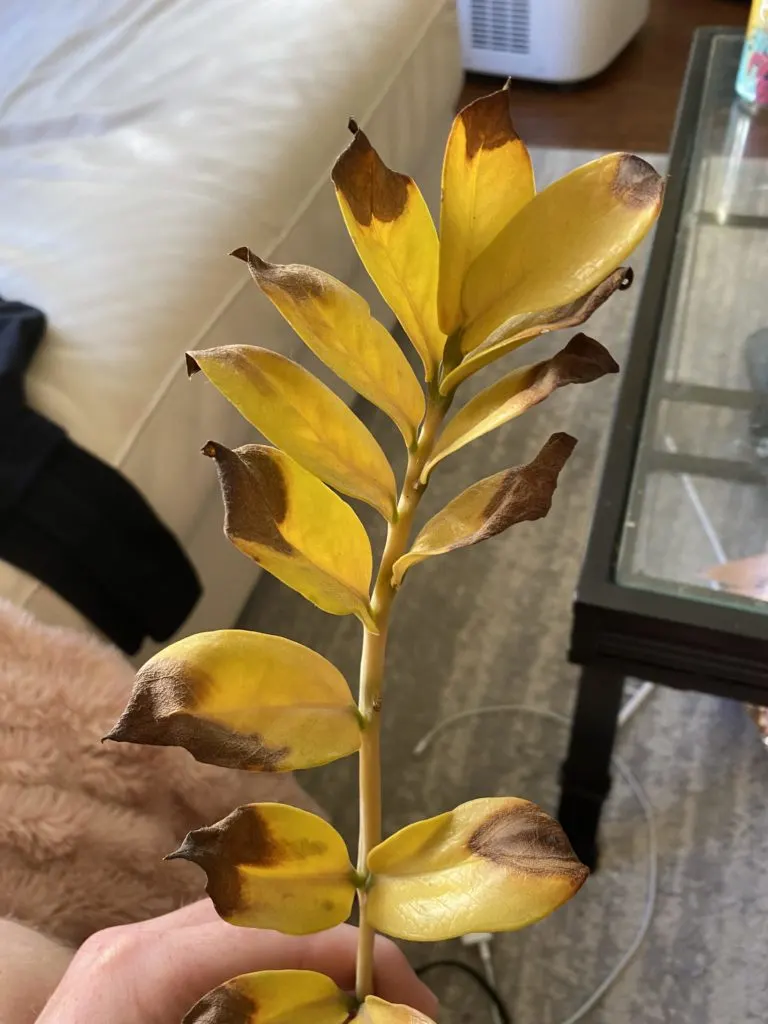To be honest, there are many reasons for a ZZ plant to turn yellow.
Although the yellowing of leaves in ZZ plants is a common problem that people usually experience.
Still, seeing the leaves turning yellow in your plant, you might think, “Why is my ZZ plant turning yellow?”
To get a decent answer, stay with me as I deal with all the possible causes responsible for the yellowing of leaves in ZZ plants.

Let’s converse a bit about the ZZ plant.
Zamioculcas Zamiifolia – aka the ZZ Plant
Zamioculcas zamiifolia has become one of the most popular indoor ornamental houseplants in recent years.
Possessing the unparallel charm and beauty of glossy dark green foliage, the ZZ plant has effortlessly gained a remarkable position in numerous hearts, homes, and offices.
Therefore, being somewhat concerned about it is absolutely understandable.
Zamioculcas zamiifolia — aka the ZZ plant, is a monotypic species of a unique flowering plant genus from the Aroid family Araceae.
The ZZ plant is loyal even to its disloyal parents! It can tolerate months of neglect. Literally, months!
But the moment when your desertion hits the highest point, your ZZ plant — reflecting all the moments when its enchanting beauty was overlooked — would turn yellow.
So, in this article, we will tackle the most common mistakes that can cause the yellowing of leaves in ZZ plants.
Why Is My ZZ Plant Turning Yellow?
When I think, why is my ZZ plant turning yellow? The first thing that comes into my mind is overwatering.
1. Overwatering Can Cause ZZ Plants to Turn Yellow
As with all succulents, overwatering can lead to a disaster. ZZ plant is an evergreen perennial with leaves that are succulent in nature.
Moreover, if you study the rhizosphere of Zamioculcas zamiifolia, you’ll identify that the roots in these plants are actually in the form of root tubers that look like potatoes. These rhizomes store water for future use when the plant suffers during drought conditions.
That’s the main reason why ZZ plants are incredibly drought-resistant. Being a pretty resilient plant makes this demanding beauty a perfect choice for beginners and casual gardeners.
What Happens When You Overwater Your ZZ Plants?
When you overwater your ZZ plants for a long time, the roots constantly remain in a pool of water. This usually happens when you keep overwatering your ZZs for an extended period.
Roots consistently sitting in damp conditions can quickly become susceptible to severe root rot.
What really happens is that the roots (rhizomes in this case) and the rootlets can’t breathe in overly watered conditions, leading to suffocation and death. These dead rootlets are highly susceptible to rot.
Overwatered plants are also prone to many fungal diseases that lead to the yellowing of leaves.
“Yellowing of leaves is the foremost visual symptom if your ZZ plant is suffering from root rot.”
You can read all about root rot and how to treat it in the following article.
>>> Related Article: What Does Root Rot Look Like? Symptoms, Causes, and Treatment.
2. Underwatering Can Cause Yellowing of Leaves in ZZ Plants
On the other hand, underwatering can also cause the yellowing of leaves in your ZZ plants.
As I said earlier, ZZ plants can keep up with the water crisis.
But it only applies to a limit; they have feelings too!
Therefore, if you leave them sitting in a dry corner for an eternity, not showing any interest in giving them a shot of hydration, you are going to see your ZZ plants turning yellow.
How to Properly Water ZZ Plants?
If both over and under watering are possible answers to “Why is my ZZ plant turning yellow?” Then how can I properly water my ZZ plant?
To be honest, a watering schedule directly depends upon the physical conditions you provide to your plants, like the intensity of light, temperature, humidity, and the potting mix.
A ZZ plant sitting in a hot and dry environment would require more water than one in cold and moist conditions.
“Generally, the rule of thumb for watering is that you only water the ZZ plant when the soil or the potting mix gets entirely dry.”
- Water your ZZ plant thoroughly until it fully seeps out from the bottom drainage holes.
- Use an appropriate potting mix that contains a good amount of perlite or pumice.
After skimming through the following article, you can make the best potting mix for your succulents.
>>> Related Article: How to Make the Best Potting Mix for Indoor Plants According to the Nature of Your Plants Themselves.
3. Sunburn
Giving your ZZ plant more than 4 hours of direct sunlight? Well… it’s sunburn, my friend.

ZZs are plants that thrive in low to medium light conditions. That’s why giving your ZZ plants more light than required can turn them yellow.
You’ll also see brown tips or edges if the yellowing of leaves is related to an excessive amount of light.
How to Fix
Just move your plant to a place where it gets enough moderate light. Indirect sunlight filtered using curtains or sunshades works best.
This property makes the ZZ plants perfect for homes and offices.
4. Pest Infestations Lead to Yellowing of Leaves in ZZ Plants
Lastly, the thing from which you should keep your ZZ plant away is the sap-sucking pests.
These nasty pests such as scales, spider mites, and mealybugs can suck the life out of your plants. As a result, your ZZ plant turns yellow.
A stressed or overwatered ZZ plant is more susceptible to pests infestation.
How to Get Rid of Pests?
“Prevention is better than cure.”
Well… Desiderius Erasmus said that. So, it is always better to provide your ZZ plants with appropriate lighting and proper watering.
You can follow the following methods to control pest infestations.
- First of all, isolate your infested plants. Pests like scales, spider mites, and mealybugs are contagious and can infect other plants.
- Bugs like spider mites can be washed away using a pressurized stream of water.
- Mealybugs are treated by applying rubbing alcohol to the plant.
The above methods only work in a continuous application for up to a week.
However, the best way to get rid of these nasty pests is to use horticultural oil sprays. Neem oil is a common one most people use. You can also practice ready-to-use pesticides or insecticides labeled for indoor plants.
>>> Related Article: How to Get Rid of Harmful Pests of Your Garden?
Conclusion
With all that said, I hope you got a satisfying answer to “Why is my ZZ plant turning yellow?”
Consider sharing this article with your friends and family if you find it helpful. Also, feel free to share your thoughts or queries with us in the comments below.
On that note, let’s conclude the talk. 😉
Regards, Mahad H.
